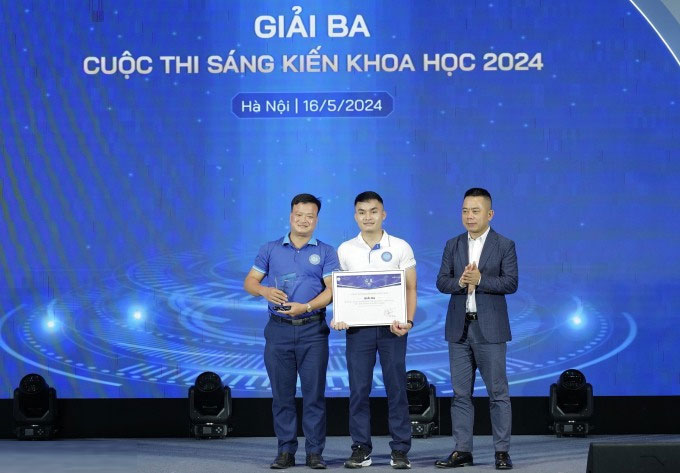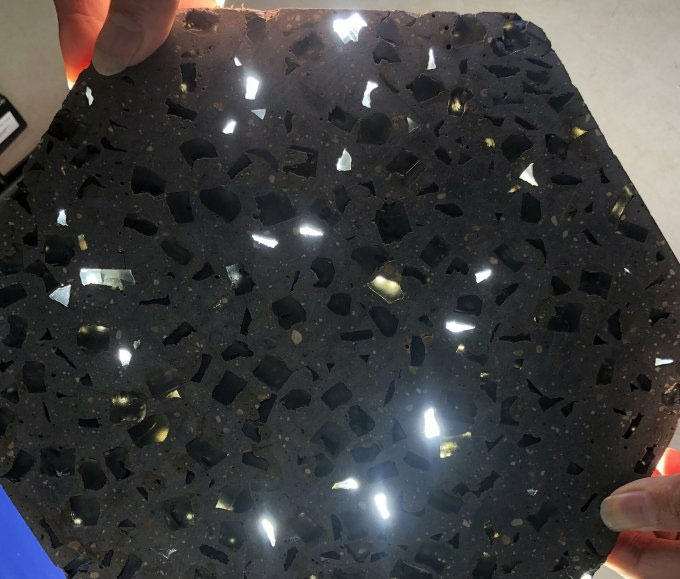Concrete made from fly ash waste and glass can transmit light
A group of scientists took advantage of waste fly ash and slag at the bottom of a waste-burning power plant to combine glass to create concrete that can transmit light, winning the third prize of Science Innovation 2024.
The product was researched and tested by the "green" concrete group of the University of Mining and Geology . Highlights of "green" concrete products are good light transmittance, high strength and absolutely no use of cement. This is an unprecedented type of concrete on the Vietnamese market, especially the light-conducting material is used from waste glass, replacing expensive fiber optic cables like existing light-emitting concretes in the world. .

Associate Professor. Dr. Mai Anh Tuan, Head of the jury of the 2024 Scientific Innovation Contest awarded third prize to the author group. (Photo: Ngoc Thanh).
Sharing with reporters , Dr. Tang Van Lam, 41 years old, representative of the research team, said that the project has been implemented since the beginning of 2021 with the goal of reducing pressure on processing and using more thoroughly all types of industrial waste, especially industrial waste. especially ash and slag from thermal power plants and metallurgy. Thereby minimizing the amount of cement and reducing the impact of toxic gases and dust during the cement production process. The research also solves the problem of scarcity of green materials for the construction process.
The group offers technology to reuse fly ash waste, furnace bottom slag and water filtration plant sludge combined with waste glass. By making the most of solid waste, especially using waste glass beads for the purpose of allowing light to pass through, the price of the product is cheaper. "Green" concrete products use ash, slag, and sewage sludge to completely replace cement with good mechanical properties with a compressive strength that can reach 60 MPa based on 10 cm cube test samples. .

Light-transmitting green concrete panels were manufactured by the research team. (Photo: Research team).
Manufactured products are in the form of thin sheets, square, rectangular or hexagonal in size with a thickness of about 10 mm to 15 mm. The concrete surface is ground and polished. This process is important because it determines the extent to which waste glass particles used in the concrete are exposed. The quality of the product's light transmission also completely depends on this process. Waste glass beads help natural and artificial light pass through concrete panels.
According to Dr. Lam, the difficulty in research is that waste glass particles can affect the safety of users because they are very sharp. To fix it, the team used a layer of liquid glass applied to the surface to give the product a beautiful and safe shine.
Light-transmitting green concrete is considered useful when used in decorative structures in construction projects, widely used in interior and exterior decoration of buildings, creating architectural effects in terms of color and light. unique.
However, this product has some disadvantages such as not being able to create light combined with patterns. In the coming time, the team will continue to research new manufacturing methods, creating products that can transmit light in certain directions, creating better lighting effects.

Experimental shaping stage in the laboratory. (Photo: Research team).
Evaluating the project, Dr. Hoang Minh Duc, Director of the Institute of Concrete Specialization, Institute of Construction Science and Technology (IBST) said that the research is suggestive of ways to simultaneously process various types of waste to create products. new. He suggested that to continue perfecting the product, the team could delve deeper into clarifying the interaction mechanism between components, the ability of this material to isolate hazardous substances in waste, and optimize the technology according to the following criteria: required properties, especially the ability to transmit light . "In terms of the market, in the immediate future the group should orient the application of this material for decorative and fine art products, including combining this material with traditional materials," he said.
The solution of the "green" concrete group of the University of Mining and Geology received the third prize worth 30 million VND at the 2024 Scientific Innovation contest organized by VnExpress newspaper. Associate Professor, Dr. Dao Van Duong, member of the Jury Council, recognized that the product is useful when used in decorative structures in construction projects, and at the same time green technology also contributes to implementing the policy of sustainable "green" transformation. solid. He appreciated the idea of using glass to transmit light creatively, but suggested that the group needed to research more closely on the waste materials market as well as a scientific approach to the product's bearing capacity and light transmission value. Products.
- Mexico invented eco-cement made from glass chips and garbage
- MR6: Road carpet concrete from waste plastic waste
- Develop new mixed concrete from thermal power industry waste
- Scientists have successfully developed a new type of concrete that is less prone to cracking than conventional concrete
- Concrete is devastatingly natural as much as plastic waste
- Glass has the ability to 'transform' when meeting water
- The reason we should classify glass junk
- Self-cleaning glass
- Technology turns waste into non-toxic glass
- The new solution uses sparks to recycle concrete
- Build houses from coconut shells
- ERO: Concrete demolition robot
 'Barefoot engineer' invents a pipeless pump
'Barefoot engineer' invents a pipeless pump Process of handling dead pigs due to disease
Process of handling dead pigs due to disease Radiometer
Radiometer Warp Engine: Technology brings us closer to the speed of light
Warp Engine: Technology brings us closer to the speed of light